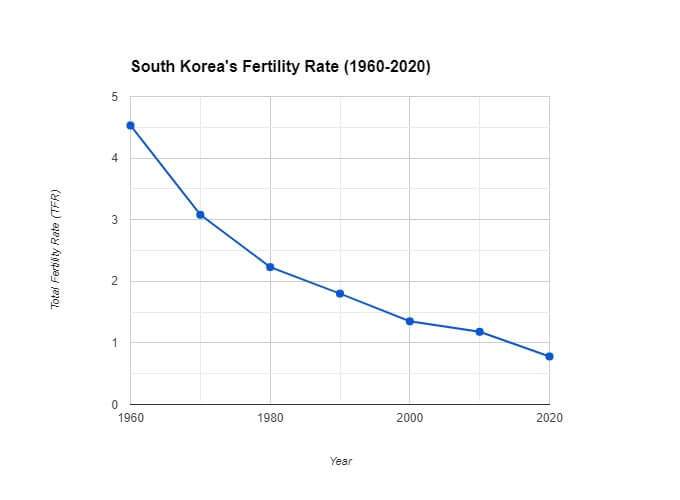The Demographic Puzzle: Unraveling the Lowest Fertility Rate in the World
The world’s population is on the rise, but not everywhere. Some countries, particularly high-income nations, are facing a starkly different reality: plummeting birth rates. Among them, South Korea stands out with the lowest fertility rate globally, raising critical questions about its future and offering insights into potential challenges for other low-fertility countries.
A Snapshot of South Korea’s Fertility Crisis
As of 2022, the average South Korean woman has 0.78 children in her lifetime, far below the replacement rate of 2.1 needed to maintain a stable population. This alarmingly low figure represents a significant decline from just a few decades ago, when the rate hovered around 4.5 in the 1960s.
What’s driving this dramatic shift? Several factors intertwine:
Economic pressures: Soaring housing costs, high living expenses, and competitive job markets make raising children financially demanding.
Changing social norms: Women are pursuing higher education and careers, often delaying or opting out of motherhood altogether.
Work-life imbalance: Long working hours and limited childcare options leave little time and support for families.
Cultural shift: Individualism and materialism prevail, leading to smaller families and prioritizing personal aspirations over traditional family structures.
The consequences of this low fertility rate are multifaceted:
Aging population: The proportion of elderly citizens is rapidly increasing, placing a strain on social security and healthcare systems.
Shrinking workforce: A declining working-age population could hinder economic growth and innovation.
Military implications: South Korea faces unique security challenges, and a smaller pool of potential recruits raises concerns about future defense capabilities.

Beyond South Korea: A Global Trend?
Singapore:
Sharing many similarities with South Korea, Singapore paints a near-identical picture. Boasting a fertility rate of 1.05, it faces similar pressures of soaring living costs, long working hours, and changing societal values that prioritize career aspirations over large families. The government has implemented various policies like extended parental leave, housing subsidies, and flexible work arrangements, but the effectiveness remains an ongoing debate.
Taiwan:
With a rate of 1.09, Taiwan mirrors the challenges of its East Asian neighbors. The long-held cultural emphasis on education and career success, coupled with economic anxieties and limited childcare options, contribute to the downward trend. The government has introduced incentives like cash allowances for newborns and tax breaks for working mothers, yet cultural shifts remain crucial for long-term impact.
Eastern Europe:
Countries like Moldova, Lithuania, and Ukraine paint a different picture. Here, the legacy of historical events and economic instability intertwine with changing social norms. Factors like mass emigration, economic hardship, and the collapse of traditional family structures contribute to the low rates (around 1.2-1.5). Addressing poverty, improving living standards, and fostering support for families are key elements in tackling this complex issue.
Developed Western Nations:
While not quite matching the lows of East Asia, several European countries and Japan exhibit concerning tendencies. Germany (1.53), Italy (1.24), and Japan (1.30) face pressures like aging populations, declining marriage rates, and high costs associated with child-rearing. Addressing work-life balance, promoting affordable childcare, and encouraging pro-family policies are some strategies these nations are exploring.
Beyond National Borders:
It’s essential to remember that the low-fertility phenomenon extends beyond individual countries. The European Union, as a whole, has a fertility rate of 1.53, indicating a widespread challenge across developed regions. Similarly, East and Southeast Asia stand out as a region with particularly low rates (average of 1.64), raising concerns about future demographic structures and economic implications.
Understanding the Nuances:
It’s vital to avoid oversimplification when analyzing these trends. Fertility rates vary within countries, with significant disparities between urban and rural areas, different socioeconomic groups, and ethnicities. Cultural traditions, religious beliefs, and access to education also play significant roles.
Seeking Solutions, Embracing Diversity: While there’s no one-size-fits-all answer, some common themes emerge in potential solutions. Supporting families through economic assistance, affordable childcare, and flexible work arrangements are crucial. Addressing cultural norms and promoting work-life balance can also have a significant impact. Additionally, immigration policies that attract skilled workers while ensuring social integration offer another avenue for navigating demographic imbalances.
The Road Ahead: The global picture of low fertility rates presents a complex puzzle with far-reaching implications. By understanding the diverse factors at play in different countries and regions, we can craft nuanced solutions that support families, foster societal well-being, and ensure a sustainable future for all. It’s a journey that requires collective effort, open-mindedness, and a commitment to addressing the unique challenges faced by each nation and community.
Navigating the Future: Potential Solutions
Addressing the low-fertility challenge requires comprehensive strategies. Here are some potential solutions:
Economic support: Policies, like paid parental leave, affordable childcare, and financial aid for families, can alleviate financial burdens.
Work-life balance: Promoting flexible work arrangements, shorter working hours, and accessible childcare facilities can empower families to manage work and family life effectively.
Cultural shift: Reframing societal narratives around family size and promoting supportive social structures can create a more nurturing environment for families.
Immigration: Welcoming skilled immigrants can help supplement the workforce and address demographic imbalances.
It’s important to acknowledge that these solutions present their own challenges and require careful consideration of cultural and social contexts.
Conclusion
The lowest fertility rate in the world, observed in South Korea, serves as a stark reminder of the demographic challenges facing many developed nations. Understanding the complex factors behind this trend and exploring potential solutions are crucial for shaping a sustainable future where individuals and societies can thrive. While the path forward may be complex, acknowledging the challenges and fostering supportive environments for families remains central to navigating this global demographic shift.
Frequently Asked Questions (FAQ)
Q: What are the long-term implications of low fertility rates?
A: Long-term impacts include an aging population, shrinking workforce, potential economic stagnation, and strain on social security systems.
Q: Does immigration solve the low fertility problem?
A: Immigration can help address workforce shortages and demographic imbalances, but it’s not a substitute for addressing the root causes of low fertility. Integration and social cohesion are crucial aspects to consider.
Q: Are there cultural differences in attitudes toward family size?
A: Yes, cultural norms and values significantly influence family planning decisions. What’s considered ideal family size can vary greatly across different cultures.
Q: What are the ethical considerations of addressing low fertility rates?
A: Policies need to respect individual choices and avoid coercion or pressure on families. Ensuring equal access to opportunities and promoting a supportive environment for families are key considerations.
Q: What can individuals do to support solutions?
A: Advocating for policies that support families, challenging discriminatory norms, and creating work-life balance within organizations are all ways individuals can contribute.


